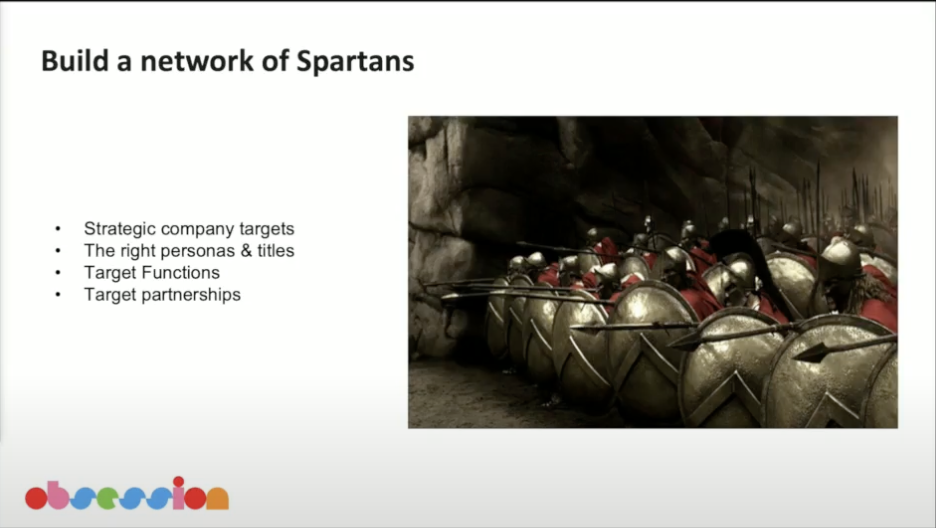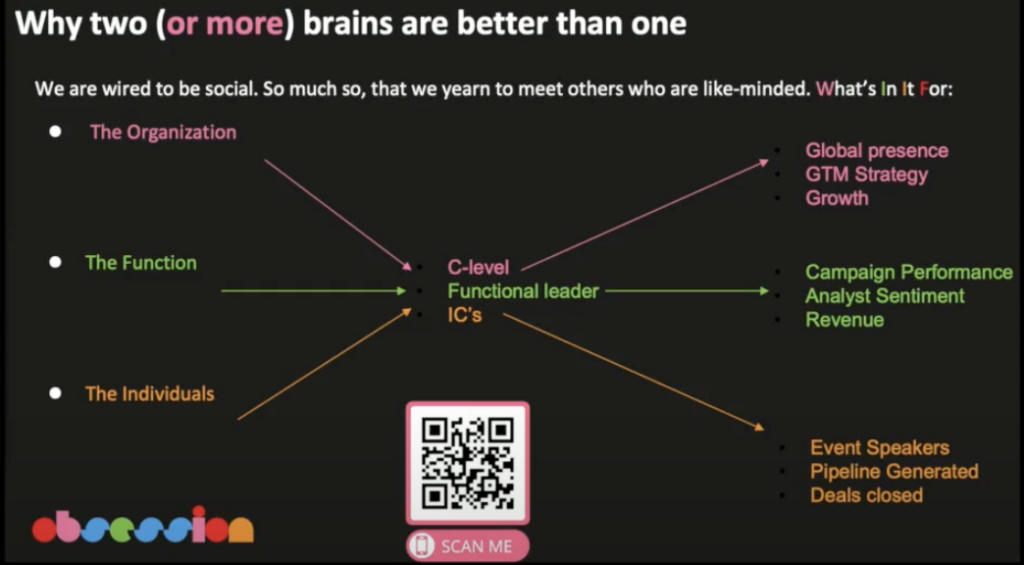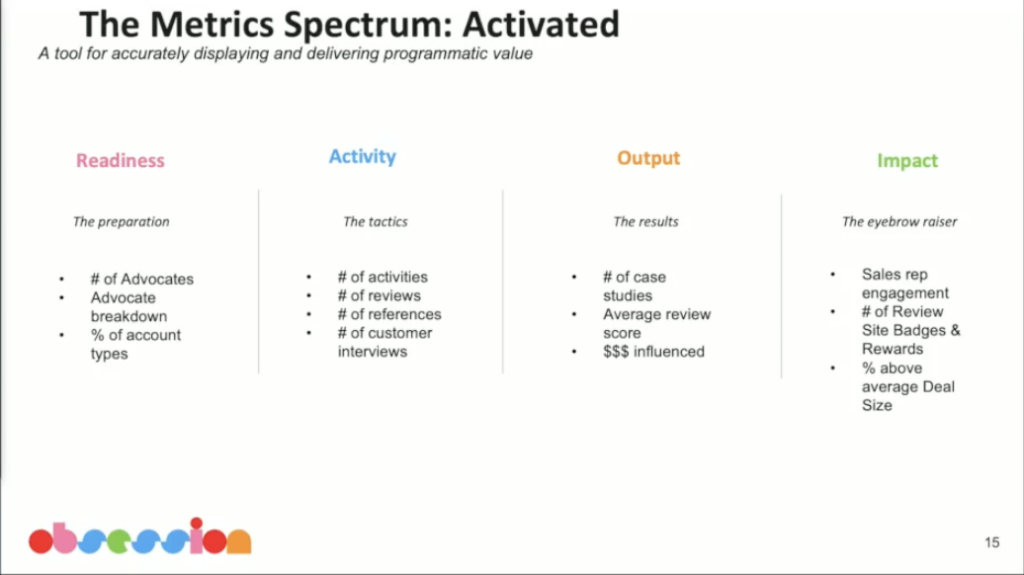Home » The Customer Led Growth Blog » Gaining Executive Buy-In & Trust with Strategic Measurement
Gaining Executive Buy-In & Trust with Strategic Measurement

Gaining Executive Buy-In & Trust with Strategic Measurement
Luis Gonzalez leads the Global Advocacy Program for Alteryx, a leading low-code/ no-code data analytics platform. Luis says Alteryx are all about “turning mere mortals into data superheroes”, some of which they call Alteryx Innovators and Alteryx Visionaries, advocates that are deployed cross functionally in Demand Marketing, AR, Solutions Marketing, PR, and this year also HR.
As the Global Customer Advocacy Program Leader, Luis is “obsessed” with customer relationships. His primary focus is on delivering impact throughout the entire organization and reporting on that impact to gain the executive buy-in and trust required to constantly grow his programs.
During his session at Obsession Summit, Luis outlined his extremely effective approach focused on consistently improving the customer experience and shared his insights and best practices for building an impactful customer marketing program.
Here’s some of what we learned from Luis’s Obsession Summit session.
Customer Obsession
“Obsess like an artist, measure like a scientist,” this is how Luis defines his work in Customer Marketing. Customer marketing, like many other creative endeavors, calls for a healthy amount of obsession with the programs and how one might push them to the next level. Yet, like scientists, marketers must equally obsess with measuring the overall results of each campaign rather than a single KPI like direct sales.
In the end, companies put a lot of money into their customer marketing activities and they need to be geared to measure the impact of these programs on customer retention, customer churn rates, customer loyalty, brand advocacy, and community participation.
Quality Over Quantity
People frequently fall victim to the misconception that the greater quantity of something, the better it is. What prevents businesses from achieving the level of buy-in and participation they seek if this is the case? Therefore, if you’re in charge of customer marketing you should take a moment to ask yourself: “Am I trying to put myself in the shoes of my internal stakeholders?”
If this is not the case, it may be necessary to adopt a new mentality; put yourselves in the position of the internal stakeholders and advocates who believe in your cause. This is the only way you can discover the quality and genuine value of your efforts, as opposed to the superficial quantity of activities.
Program owners frequently face challenges when attempting to define and provide reports demonstrating progress on many levels. These are further compounded by the typical operational challenges of limited headcount and resources. Thus, to shift focus to quality rather than quantity, focus on measuring your customer marketing efforts with these top-level metrics:
- Advocates: Ensure that you report on the number of advocates but also on their strategic performance. Include information such as what industries they come from, what functions they work in, are they line of business decision makers, and any other relevant information.
- Reviews: Do not merely report on the stats you drew up for the previous quarter; rather, explain that you have driven the needle in the proper direction, with your finger on the market’s pulse, which constantly monitors how your brand is perceived in the market. Things like achieving category leadership badges on G2, TrustRadius and Gartner are more important – and impactful – than the number of reviews.
- Case Studies: Instead of simply focusing on the products themselves, how great they are, and how they are increasing ROI, the stories you write should focus on how the business is impacted and how the impact is supported by your activities.
Build a Network of “Spartans”

After shifting your perspective from quantity to quality, it is time to build your network of Spartans. In doing so, it pays to focus again on advocates’ quality rather than quantity. Luis says this metric is directly correlated with advocacy readiness.
No matter how few advocates you have, if you are highly selective in choosing those advocates and make sure they align with the needs, demands, and standards of the company, you will have advocacy activities that impact the organization.
In the end, being highly selective will allow you to deliver on those metrics that will gain the executive buy-in you need to move forward. It is important to create a positive atmosphere and attitude of Spartans among your advocates that are ready to act on your behalf and are aligned with:
- Strategic company targets
- Right personas and titles
- Target functions
- Target partnerships
Providing Multilevel Value: The Almighty WIIFM
Motivating your army of advocates does not end in creating a network of like-minded advocates; this network should prove to be of multilevel, mutual value. Your stakeholders want to know what they stand to gain from being an advocate and you have to deliver on that.

To better understand this idea, Luis presents the concept of brain-to-brain coupling, which means that birds of the same feather flock together. Brain-to-brain coupling posits that people are wired to align closely with others that are like them: People want to be in the same room with like-minded people that are ready to help them.
Within the framework of customer marketing, it is essential to deliver value at three distinct levels: the organization, the function, and the individuals.
At the organizational level, brain-to-brain coupling with the heads of the organization means advocates share and contribute to the same goals and pursuits as the C-level executives in areas such as:
- Global Presence
- GTM Strategy
- Growth
How do we align advocates to that? At the functional level, brain-to-brain coupling means that advocates share and contribute to the same goals and pursuits as the functional leaders in areas such as:
- Campaign Performance
- Analyst Sentiment
- Revenue
At the individual level, brain-to-brain coupling means that advocates share and contribute to the same goals and pursuits as the ICs in areas such as:
- Events
- Pipeline Generation
- Closing Deals
The Four Metric Families
Luis presents what he calls the metrics spectrum, a tool that displays and accurately delivers programmatic value, using four families of metrics. These four families include metric class and metric type:
Readiness: Involves the preparation of:
- Number of Advocates
- Advocate Breakdown
- Percentage of Account Type
Activity: Involves the tactics that your network of “Spartans” is ready to act on the:
- Number of Activities
- Number of Reviews
- Number of References
- Number of Customer Interviews
Output: Involves the results that advocates are producing, such as:
- Large Numbers of Case Studies
- Average Review Scores
- Revenue
Impact: Involves the eyebrow raiser wherein the output drives impact to functional leaders, such as:
- Sales Representative Engagement
- Number of Review Site Badges and Rewards
- Percentage Above Average Deal Size

The Formula For Success
Ultimately, a successful customer marketing strategy will be one that delivers the impact that your organization and its stakeholders can relate to. In addition to making a difference in your stakeholder’s wallet, you can make a lasting difference in the world around you through this marketing strategy
Effective advocacy from satisfied customers can be extremely beneficial to a company of any size, so do not overlook the opportunity to capitalize on it. Keep in mind the importance of putting in the time and effort required to learn about the metrics that matter to you, and develop a marketing strategy that centers on them so you can continue to grow your programs and your impact.
Watch Luis’s full session here and hear his story.
On edge about the next Obsession Summit? Sign up for an early invite here.

